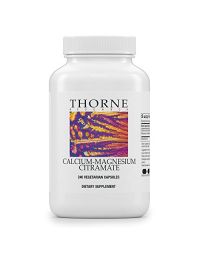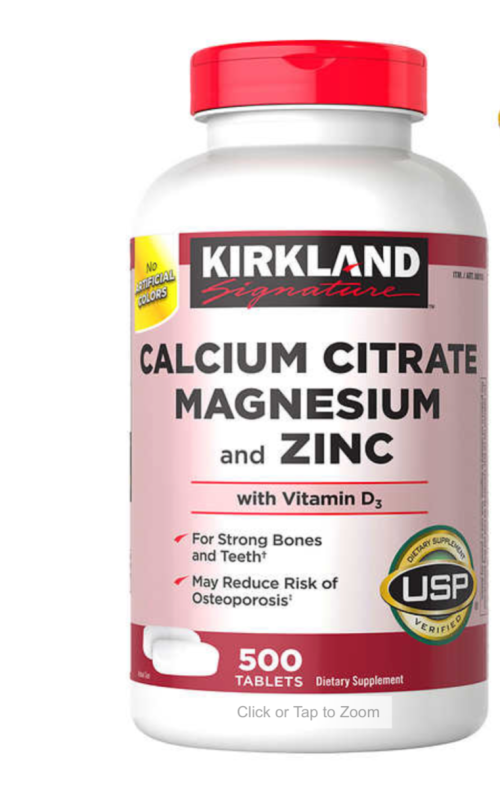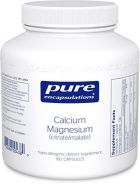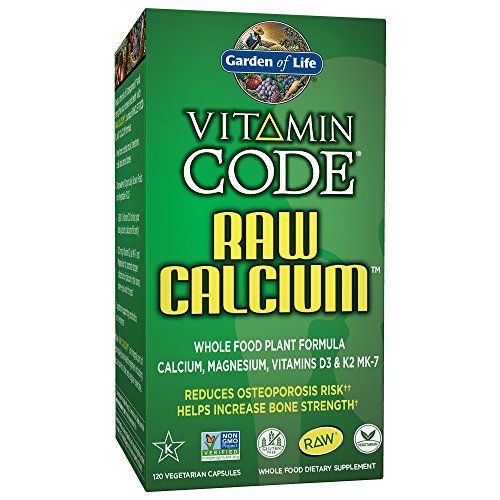Calcium and magnesium are important for bone mineralization, but also for other cellular processes. These minerals work best when taken together, and when taken in highly bioavailable forms.
”Since calcium plays an important role in skeletal and smooth muscle contraction, a state of magnesium depletion may result in muscle cramps, hypertension, and coronary and cerebral vasospasms." (NIH.gov)
”Since calcium plays an important role in skeletal and smooth muscle contraction, a state of magnesium depletion may result in muscle cramps, hypertension, and coronary and cerebral vasospasms." (NIH.gov)

Calcium is famous for its role in bone strength. Calcium atoms are a major component of hydroxyapatite, the mineral that makes up 70% of bone tissue by weight and provides much of the structural strength of your skeleton. When the concentration of calcium in your bloodstream is sufficient, osteoblasts deposit this mineral into your bones. If you are deficient in calcium, however, osteoclasts will release calcium from your bones back into your bloodstream. That is why it is recommended that you get enough calcium in your diet to prevent osteoporosis.1
Other minerals are also incorporated into the structure of your bones. Magnesium is one of these, and is necessary for proper bone mineral deposition. Dietary deficiency of magnesium can also lead to osteoporosis, increasing your risk of falling and fracturing a bone.2
Calcium is famous for its role in bone strength. Calcium atoms are a major component of hydroxyapatite, the mineral that makes up 70% of bone tissue by weight and provides much of the structural strength of your skeleton. When the concentration of calcium in your bloodstream is sufficient, osteoblasts deposit this mineral into your bones. If you are deficient in calcium, however, osteoclasts will release calcium from your bones back into your bloodstream. That is why it is recommended that you get enough calcium in your diet to prevent osteoporosis.1
Other minerals are also incorporated into the structure of your bones. Magnesium is one of these, and is necessary for proper bone mineral deposition. Dietary deficiency of magnesium can also lead to osteoporosis, increasing your risk of falling and fracturing a bone.2
Calcium is famous for its role in bone strength. Calcium atoms are a major component of hydroxyapatite, the mineral that makes up 70% of bone tissue by weight and provides much of the structural strength of your skeleton. When the concentration of calcium in your bloodstream is sufficient, osteoblasts deposit this mineral into your bones. If you are deficient in calcium, however, osteoclasts will release calcium from your bones back into your bloodstream. That is why it is recommended that you get enough calcium in your diet to prevent osteoporosis.1
Other minerals are also incorporated into the structure of your bones. Magnesium is one of these, and is necessary for proper bone mineral deposition. Dietary deficiency of magnesium can also lead to osteoporosis, increasing your risk of falling and fracturing a bone.2


Other Health Benefits of Calcium
Calcium ions are important signaling molecules for many different cellular functions. It is an electrolyte and is used to send electrical impulses through neurons. This is especially critical for the proper rhythmic beating of your heart, since the nodes that control the contractions of heart muscles use calcium ion signals to coordinate their timing.3 Nerves use calcium to conduct signals from your brain to your other muscles. If you have a calcium deficiency (called hypocalcemia), you may experience muscle cramps or spasms, feel tingling in your extremities, or have mood disorders or problems with memory or concentration.4
Calcium also serves as a regulatory molecule within your cells. Calcium ions control various channels within cellular membranes, opening and closing them to control what molecules come into your cells and into their internal compartments, such as their nucleus and mitochondria. Calcium signaling also activates certain metabolic events, such as apoptosis (cell death) and the Krebs cycle (for energy production).5
Calcium ions are important signaling molecules for many different cellular functions. It is an electrolyte and is used to send electrical impulses through neurons. This is especially critical for the proper rhythmic beating of your heart, since the nodes that control the contractions of heart muscles use calcium ion signals to coordinate their timing.3 Nerves use calcium to conduct signals from your brain to your other muscles. If you have a calcium deficiency (called hypocalcemia), you may experience muscle cramps or spasms, feel tingling in your extremities, or have mood disorders or problems with memory or concentration.4
Calcium also serves as a regulatory molecule within your cells. Calcium ions control various channels within cellular membranes, opening and closing them to control what molecules come into your cells and into their internal compartments, such as their nucleus and mitochondria. Calcium signaling also activates certain metabolic events, such as apoptosis (cell death) and the Krebs cycle (for energy production).5

Magnesium is used as a cofactor by many of your cells’ enzymes. These enzymes include those that produce cellular energy, synthesize DNA, and transcribe genes for protein synthesis. Magnesium also helps to regulate the production and activity of other signaling molecules, including those involved in calcium regulation. Similar to calcium, magnesium ions also are used to control some membrane channels within your cells.6 Symptoms of magnesium deficiency are similar to those of hypocalcemia, and include arrhythmia, muscle weakness and spasms, seizures, and mood disorders and other mental dysfunction.7 Conversely, magnesium supplementation can help lower blood pressure and improve cardiovascular and mental health.8
Magnesium is used as a cofactor by many of your cells’ enzymes. These enzymes include those that produce cellular energy, synthesize DNA, and transcribe genes for protein synthesis. Magnesium also helps to regulate the production and activity of other signaling molecules, including those involved in calcium regulation. Similar to calcium, magnesium ions also are used to control some membrane channels within your cells.6 Symptoms of magnesium deficiency are similar to those of hypocalcemia, and include arrhythmia, muscle weakness and spasms, seizures, and mood disorders and other mental dysfunction.7 Conversely, magnesium supplementation can help lower blood pressure and improve cardiovascular and mental health.8
Magnesium is used as a cofactor by many of your cells’ enzymes. These enzymes include those that produce cellular energy, synthesize DNA, and transcribe genes for protein synthesis. Magnesium also helps to regulate the production and activity of other signaling molecules, including those involved in calcium regulation. Similar to calcium, magnesium ions also are used to control some membrane channels within your cells.6 Symptoms of magnesium deficiency are similar to those of hypocalcemia, and include arrhythmia, muscle weakness and spasms, seizures, and mood disorders and other mental dysfunction.7 Conversely, magnesium supplementation can help lower blood pressure and improve cardiovascular and mental health.8

Calcium and magnesium functions go hand-in-hand. Several of the enzymes that control calcium signaling are regulated by magnesium ions, and vice versa. Magnesium ions regulate some of the channels that transport calcium into and between cells, while calcium ions likewise control cellular channels for magnesium intake. Magnesium is also necessary for incorporation of calcium into bone tissue.6,7
Because of this functional co-dependence, calcium is more effective when magnesium levels are normal, and magnesium works better when calcium levels are sufficient. For the greatest benefits, take both calcium and magnesium supplements.
Calcium and magnesium functions go hand-in-hand. Several of the enzymes that control calcium signaling are regulated by magnesium ions, and vice versa. Magnesium ions regulate some of the channels that transport calcium into and between cells, while calcium ions likewise control cellular channels for magnesium intake. Magnesium is also necessary for incorporation of calcium into bone tissue.6,7
Because of this functional co-dependence, calcium is more effective when magnesium levels are normal, and magnesium works better when calcium levels are sufficient. For the greatest benefits, take both calcium and magnesium supplements.
Calcium and magnesium functions go hand-in-hand. Several of the enzymes that control calcium signaling are regulated by magnesium ions, and vice versa. Magnesium ions regulate some of the channels that transport calcium into and between cells, while calcium ions likewise control cellular channels for magnesium intake. Magnesium is also necessary for incorporation of calcium into bone tissue.6,7
Because of this functional co-dependence, calcium is more effective when magnesium levels are normal, and magnesium works better when calcium levels are sufficient. For the greatest benefits, take both calcium and magnesium supplements.

Dietary sources of vitamins and minerals are usually in their most bioavailable forms. This means that your body can use them quickly and does not have to spend extra energy converting them into a form it can use.
Dairy products, such as milk, eggs, cheese, and yogurt, are well-known for being good sources of calcium. Calcium can be obtained from non-dairy sources as well, such as cruciferous vegetables, soybeans, and oranges. The shells on shrimp and the bones in sardines are also high in calcium content.9 Nuts, beans, seeds, and grains are all good sources of magnesium. Magnesium can also be obtained from seafood and certain vegetables like spinach, okra, and prickly pear cactus.10
Dietary sources of vitamins and minerals are usually in their most bioavailable forms. This means that your body can use them quickly and does not have to spend extra energy converting them into a form it can use.
Dairy products, such as milk, eggs, cheese, and yogurt, are well-known for being good sources of calcium. Calcium can be obtained from non-dairy sources as well, such as cruciferous vegetables, soybeans, and oranges. The shells on shrimp and the bones in sardines are also high in calcium content.9 Nuts, beans, seeds, and grains are all good sources of magnesium. Magnesium can also be obtained from seafood and certain vegetables like spinach, okra, and prickly pear cactus.10


For younger adults, the recommended daily intake of calcium is 1000mg. Women over 50 years old and men over 70 years old should increase their intake to 1200mg per day. The recommended daily intake of magnesium is 400mg for young men and 420mg for men over the age of 30. Young women should consume at least 310mg magnesium each day, then 320mg each day when they are over the age of 30. Though mineral consumption through food is ideal, supplements are very helpful if you do not achieve an adequate calcium or magnesium intake through diet alone.
The calcium in supplements can come in several different forms. The most commonly-used are calcium citrate and calcium carbonate. Calcium carbonate is cheap and abundant, but should be taken with food to maximize absorption. On the other hand, calcium citrate can be taken without food.11 There are many forms of magnesium, many of which are magnesium chelated in an amino acid (like magnesium citrate). Magnesium chloride is very water-soluble and easily absorbed.12 Magnesium oxide is commonly used but is not as readily absorbable.
For younger adults, the recommended daily intake of calcium is 1000mg. Women over 50 years old and men over 70 years old should increase their intake to 1200mg per day. The recommended daily intake of magnesium is 400mg for young men and 420mg for men over the age of 30. Young women should consume at least 310mg magnesium each day, then 320mg each day when they are over the age of 30. Though mineral consumption through food is ideal, supplements are very helpful if you do not achieve an adequate calcium or magnesium intake through diet alone.
The calcium in supplements can come in several different forms. The most commonly-used are calcium citrate and calcium carbonate. Calcium carbonate is cheap and abundant, but should be taken with food to maximize absorption. On the other hand, calcium citrate can be taken without food.11 There are many forms of magnesium, many of which are magnesium chelated in an amino acid (like magnesium citrate). Magnesium chloride is very water-soluble and easily absorbed.12 Magnesium oxide is commonly used but is not as readily absorbable.
For younger adults, the recommended daily intake of calcium is 1000mg. Women over 50 years old and men over 70 years old should increase their intake to 1200mg per day. The recommended daily intake of magnesium is 400mg for young men and 420mg for men over the age of 30. Young women should consume at least 310mg magnesium each day, then 320mg each day when they are over the age of 30. Though mineral consumption through food is ideal, supplements are very helpful if you do not achieve an adequate calcium or magnesium intake through diet alone.
The calcium in supplements can come in several different forms. The most commonly-used are calcium citrate and calcium carbonate. Calcium carbonate is cheap and abundant, but should be taken with food to maximize absorption. On the other hand, calcium citrate can be taken without food.11 There are many forms of magnesium, many of which are magnesium chelated in an amino acid (like magnesium citrate). Magnesium chloride is very water-soluble and easily absorbed.12 Magnesium oxide is commonly used but is not as readily absorbable.
[1] Bukar M, Audu BM, Adesina OA, Marupa JY. 2012. “Oral health practices among pregnant women in North Eastern Nigeria.” Niger J Clin Pract. Jul-Sep; 15(3):302-305. https://www.ncbi.nlm.nih.gov/pubmed/22960965
[2] Masalu JR, Kikwilu EN, Kahabuka FK, Senkoro AR, Kida IA. 2009. “Oral health related behaviors among adult Tanzanians: a national pathfinder survey.” BMC Oral Health. Sep 14; 9:22. https://www.ncbi.nlm.nih.gov/pubmed/19751519
[3] Brooks JK, Bashirelahi N, Reynolds MA. 2017. “Charcoal and charcoal-based dentifrices: A literature review.” J Am Dent Assoc. Sep; 14(8):661-670. https://www.ncbi.nlm.nih.gov/pubmed/28599961
[4] “Black, white and shades of gray: Dental students’ research project shows in long run, charcoal toothpaste likely won’t help whiten teeth.” Creighton University News Center. April 26, 2018. http://www.creighton.edu/publicrelations/newscenter/news/2018/april2018/april262018/charcoalresultsnr042618/
[5] Singh RP, Sharma S, Logani A, Shah N, Singh S. 2016. “Comparative evaluation of tooth substance loss and its correlation with the abrasivity and chemical composition of different dentifrices.” Indian J Dent Res. Nov-Dec; 27(6):630-636. http://www.ijdr.in/article.asp?issn=0970-9290;year=2016;volume=27;issue=6;spage=630;epage=636;aulast=Singh
[6] American Dental Association. “Toothpastes.” Oral Health Topics. https://www.ada.org/en/member-center/oral-health-topics/toothpastes
[7] “Activated Charcoal.” 2016. WebMD. https://www.webmd.com/vitamins-and-supplements/activated-charcoal-uses-risks#1
-
Supplements for Ketogenic Diet
By Dr. KarenAugust 14, 2022 -
Theanine for Stress
By Dr. KarenMarch 8, 2022 -
Vegan Fish Oil Supplements
By Dr. KarenMarch 8, 2022


Search the blog
Article Categories
- All Articles (95)
- Rating Charts (1)
- Beauty & Skincare (17)
- FAQ (0)
- Hair Care (9)
- Health & Wellness (12)
- Anti-Aging (4)
- Kid's Health (0)
- Makeup (2)
- Men's Health (2)
- Oral Care (3)
- Sunscreen (7)
- Skin Tools & Treatments (10)
- Supplements (26)
- Videos (0)















